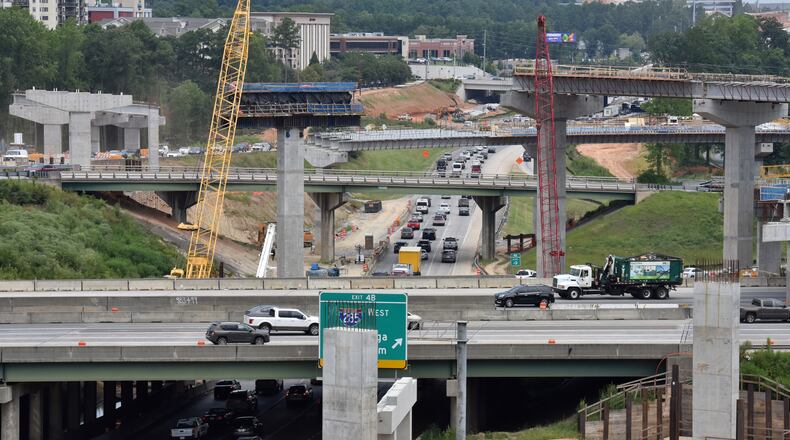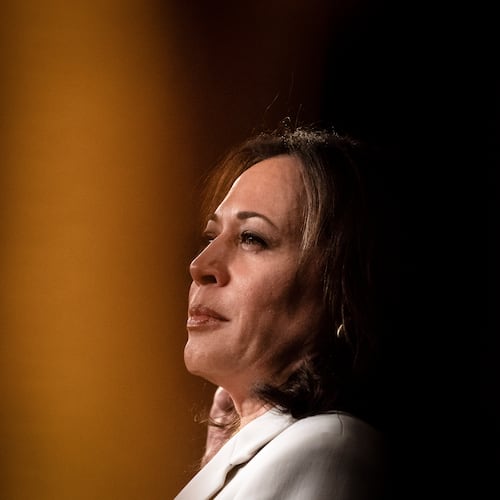Ask the average person to describe politics in Georgia, and the answer is very likely to involve two colors – red and blue. Or two shades: black and white.
But there is yet another kind of politics at work in this state, a much quieter dynamic built around the words “want” and “need.” And if you drive a car in metro Atlanta, it is something that demands your attention.
This week, my Journal-Constitution colleague David Wickert reported that the state Department of Transportation had made major changes to an $11 billion road-building program – changes that include delayed completion dates for several projects aimed at cleaning up metro Atlanta's traffic congestion:
— Toll lanes on the northern half of I-285 were to be finished by 2028. Those have been pushed back to 2032.
— Toll lanes on Ga. 400 were scheduled to be done in five years. The new completion date is 2027 – a decision with profound implications, given that the lanes were also to be the arteries for a bus rapid transit system endorsed by Gov. Nathan Deal last year.
— Meanwhile, the construction of truck lanes from Macon to McDonough on I-75 has been pushed up the priority list. As has the widening of I-85 from Braselton to Jefferson, northeast of Atlanta.
The shifts provoked immediate suspicions of a rural-suburban tug-of-war reminiscent of last year’s gubernatorial contest, with north metro Atlanta drivers on the losing end.
Last month, former state lawmaker Jay Roberts, appointed by Governor Deal as planning director to help implement the multi-billion transportation plan passed by the Legislature in 2016, resigned his position to become a lobbyist. He has not yet been replaced.
But Gov. Brian Kemp has denied any involvement in the DOT’s shift in priorities. Other parties have said the same.
And while we’re always in the market for intrigue, there is evidence of other factors at work – in fact, three different factors for three different situations. Let’s take them one at a time:
— The delay in the I-285 toll lanes is probably the most significant of the DOT changes, given the daily hours lost on that northern arc, and the cost – estimated at a hefty $4.5 billion.
The project will be broken up into three separate pieces, for a reason that makes perfect sense if you follow the doings of the state Legislature. “There are very few Georgia contractors that would probably be able to build the project as a whole,” said state Rep. Kevin Tanner, R-Dawsonville, chairman of the House Transportation Committee.
Through a middle-man, state DOT Commissioner Russell McMurry acknowledged that Tanner’s assessment is “basically correct.”
In fact, the number of Georgia contractors who have the financial wherewithal to swallow the project whole hovers right around zero.
Given the lobbying power of roadbuilders at the state Capitol, it would be politically untenable to hand a job that size to an out-of-state firm, which would then subcontract the leftovers to the locals.
The DOT maintains that dividing the I-285 toll lanes projects into smaller pieces will encourage more contractors to bid on the work, making for lower overall costs. And that may be true. But it isn’t the only truth.
Segmenting the project also ensures that more money will remain in the hands of Georgia-based contractors.
— If the I-285 decision is the most significant project impacted by DOT changes, the managed toll lanes intended for Ga. 400 are the most complicated.
North Fulton County is now a blanket of separate cities, each with its own agenda and demands. Kevin Abel, the DOT board member who represents nearly all this area, said the replacement of the Holcomb Road bridge over Ga. 400 is part of the reason that three years has been added to the timeline.
But so are negotiations that have been required by the various cities that claim parts of Ga. 400. The Northridge Road community in Sandy Springs, for instance, objected to the flyover lanes that DOT had proposed for their area. A compromise was reached last month.
McMurry, the DOT commissioner, listed the entities involved in the Ga. 400 project: Fulton and DeKalb counties, cities in both of those counties, the various community improvement districts, MARTA, the State Road and Tollway Authority, and The ATL. That last one is the new state authority intended to oversee transit in metro Atlanta.
“Collaboration and other factors pushed the schedule back from the original posted schedule,” McMurry said.
Sandy Springs Mayor Rusty Paul found that puzzling. He said he and other city officials were never told that their concerns were delaying the toll lanes. “They told us they had to make their final decisions, to stay on schedule, by December,” he said.
Other north Fulton cities worry about north-south congestion on Ga. 400. Sandy Springs is impacted by east-west congestion on I-285 as well. Which will now be delayed for four years.
“We’re going to be under duress for a long time. If we use the time wisely, to figure out the [bus rapid transit] aspects of I-285 between Doraville and SunTrust Park, then it may be worth it,” he said.
— Now, about those truck lanes. Lynn Westmoreland is the DOT board member for the same region he represented in Congress, from south of Atlanta to Columbus.
When it comes to transportation, the real tension isn’t suburban vs. rural, he said. It’s suburban vs. freight. “It’s two totally different kinds of congestion,” Westmoreland said. And it pits your ability to get to your job against a manufacturer’s ability to get goods in or out of the state.
“If people can’t get their goods distributed, they go somewhere else,” he said. Westmoreland pointed to the Kia auto plant in his district, and asked how long I thought its assembly line could run if truck traffic were halted.
Three days, I guessed. Three hours, he corrected me.
Tanner, the House transportation chairman mentioned above, will be in Dalton on Wednesday to co-chair the Georgia Commission on Freight & Logistics. Its assignment is all about moving things through Georgia, not people.
But he says metro Atlanta commuters shouldn’t worry about the shift in DOT priorities.
“I have absolutely no reason to believe that this is a political decision based on rural versus the metro area,” Tanner said. “It would be unfortunate if it got turned into that. We’ve got to spend dollars in all parts of Georgia, but we know that 49% of people in Georgia live in the 13-county region around the metro area. There’s a lot of dollars that have got to be spent there.”
About the Author
The Latest
Featured



